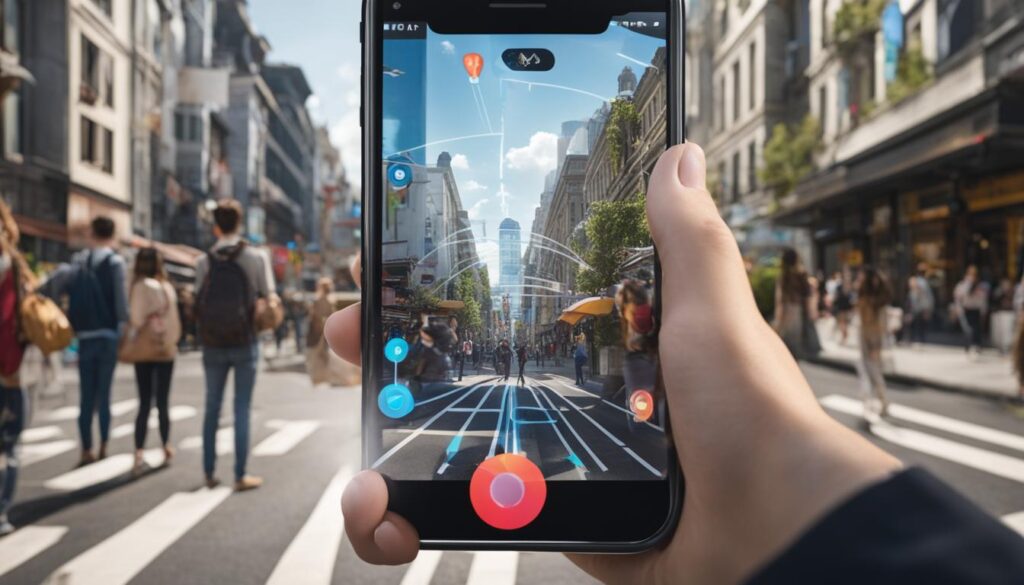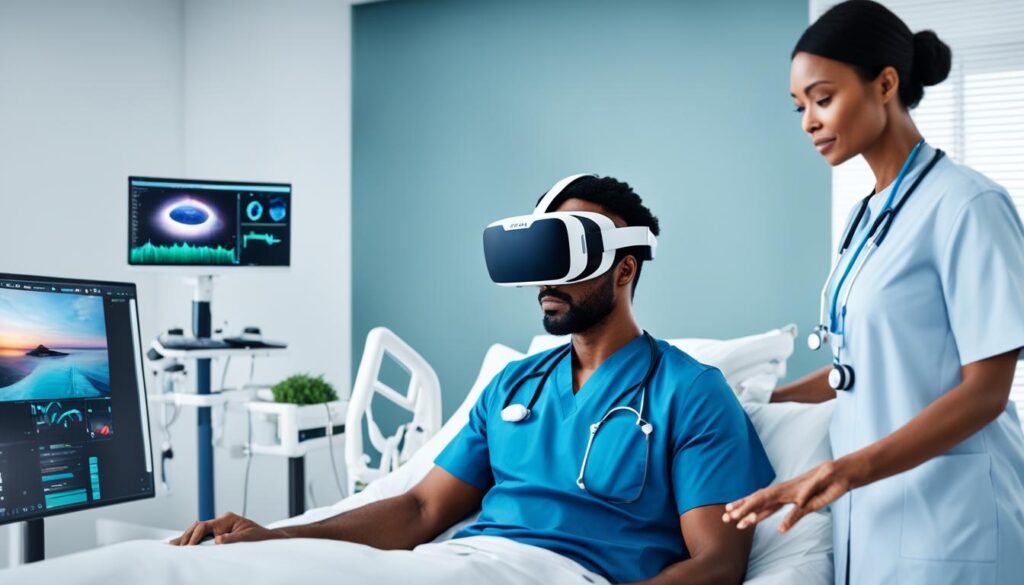Virtual and augmented reality have taken the world by storm, captivating audiences with their immersive experiences and endless possibilities. As these groundbreaking technologies continue to evolve, one question arises: Is augmented reality (AR) as mindblowing as virtual reality (VR)? Let’s dive into the comparison and find out!
Contents
- 1 Defining Virtual and Augmented Reality
- 2 Evolution and Applications of VR and AR Technology
- 3 Advantages and Disadvantages of VR
- 4 Applications of AR in Business and Brands
- 5 VR Applications and Use Cases
- 6 Conclusion
- 7 FAQ
- 7.1 Is augmented reality as mindblowing as virtual reality?
- 7.2 What is the difference between augmented reality and virtual reality?
- 7.3 What are the benefits of augmented reality?
- 7.4 What are the advantages of virtual reality?
- 7.5 What are the applications of augmented reality in business and branding?
- 7.6 What are the applications of virtual reality?
- 7.7 What is the future of virtual reality and augmented reality?
- 8 Source Links
Key Takeaways:
- AR and VR are revolutionary technologies that offer unique experiences and applications.
- While VR creates a fully immersive virtual environment, AR overlays digital information onto the real world.
- Both AR and VR have their advantages and benefits in various industries.
- The mindblowing nature of AR and VR can differ based on individual preferences and specific use cases.
- As technology continues to advance, we can expect exciting advancements in both AR and VR.
Defining Virtual and Augmented Reality
Virtual reality, or VR, is a computer-generated simulation of a 3D environment that can be interacted with in a seemingly real or physical way through specialized equipment. With VR, you can immerse yourself in a digital world and experience activities and environments that may be completely different from the physical reality you’re in.
Augmented reality, or AR, takes a different approach. It enhances reality by overlaying digital information onto the real world. AR experiences are often viewed through devices like smartphones or tablets, which use the device’s camera to blend the digital information with the user’s real-world surroundings. This creates a unique and interactive hybrid experience where the real and virtual worlds coexist.
While virtual reality fully immerses you in a simulated environment, augmented reality adds digital elements to your real-world environment, enhancing your perception and interactions. Both technologies have their distinct applications and advantages, making them incredibly fascinating and impactful in their own ways.
Visualize the concept of virtual and augmented reality with this image:
Evolution and Applications of VR and AR Technology
Virtual Reality (VR) and Augmented Reality (AR) technologies have come a long way since their early beginnings. The evolution of VR and AR technology has brought us remarkable advancements and captivating applications that have reshaped various industries.
VR Headset History
The journey of VR headsets began in the 1960s when the first VR headset, known as the Sensorama, was created. Over the years, VR headsets have undergone significant improvements in terms of design, comfort, and immersion. Today, consumers have a wide range of VR headsets and accessories to choose from, including popular brands like Oculus, HTC Vive, and PlayStation VR.
Popular AR Apps
Although VR has gained significant attention, AR has also seen remarkable advancements. Popular AR apps like Pokemon Go and Snapchat have showcased the true potential of AR technology. Pokemon Go, launched in 2016, merged the real world with virtual elements, allowing users to catch digital creatures within their physical surroundings. Snapchat, with its popular AR filters, allows users to add fun and interactive effects to their photos and videos.
Applications of VR and AR
Both VR and AR have a wide range of applications that extend beyond gaming. Let’s explore some of the key applications:
| Industry | VR Applications | AR Applications |
|---|---|---|
| Gaming | Immersive gaming experiences, virtual worlds | AR gaming overlays, interactive gameplay |
| Education and Training | Virtual simulations, immersive learning environments | AR textbooks, 3D models, virtual field trips |
| Healthcare | Surgical training, pain management, therapy | AR-guided surgeries, real-time data visualization |
| Entertainment and Tourism | Virtual concerts, virtual tourism experiences | AR virtual tours, interactive museum exhibits |

Discover the exciting benefits of augmented reality in education, healthcare, entertainment, and tourism.
Advantages and Disadvantages of VR
Virtual reality (VR) offers a variety of advantages that make it an exciting technology for both entertainment and practical applications. Let’s delve into some of the key benefits:
Creating Hyper-Realistic Environments
One of the biggest advantages of VR is its ability to transport you to hyper-realistic environments that mimic real-life experiences. Whether you’re exploring the depths of the ocean or climbing a mountain, VR can make you feel like you’re truly there.
Applications in Training Simulations
VR has found extensive use in various training simulations, such as aviation and medical training. It allows trainees to practice complex procedures in a safe and controlled environment, minimizing risks and enhancing learning outcomes.
Enhancing Healthcare
In the healthcare sector, VR technology has proved to be highly valuable. Surgeons can use VR to practice intricate procedures before performing them on patients, leading to improved surgical precision. Additionally, VR is utilized for pain management and therapeutic treatments.
Highly Engaging User Experiences
VR provides users with immersive and captivating experiences that enable them to interact with digital content in ways never before possible. The level of engagement and emotional connection that VR can create is unparalleled.
While VR offers numerous advantages, it’s important to consider its limitations as well. Here are some of the disadvantages:
Cost and Development
Developing high-quality VR experiences can be a costly endeavor. The equipment, software, and expertise required can make it inaccessible for some individuals and organizations. Additionally, the time and resources needed for VR development can be significant.
Potential Addiction and Mental Health Effects
As with any technology, VR carries the risk of addiction, particularly in gaming applications. Prolonged and excessive use of VR can have potential negative effects on mental health, although research in this area is still ongoing and inconclusive.
Overall, VR offers a range of advantages, including hyper-realistic environments, applications in training simulations and healthcare, and highly engaging user experiences. However, developers and users should also be conscious of the associated costs and potential impacts on mental health.
| Advantages of VR | Disadvantages of VR |
|---|---|
| Creates hyper-realistic environments | Cost and development challenges |
| Applications in training simulations | Potential addiction and mental health effects |
| Enhances healthcare | |
| Provides highly engaging user experiences |
Applications of AR in Business and Brands
Augmented Reality (AR) has become an integral part of business strategies and branding efforts, offering a wide range of applications and benefits. By incorporating AR technology, companies can enhance customer experiences, boost sales, and stay at the forefront of technology trends. Let’s explore some of the key applications of AR in business and brands.
Virtual Try-Ons
AR enables customers to virtually try on products before making a purchase, revolutionizing the online shopping experience. By overlaying digital images of products onto real-world environments, AR allows users to visualize how items will look and fit, eliminating the uncertainty associated with online shopping. Brands like Warby Parker and Sephora have implemented virtual try-on features, delivering personalized and interactive shopping experiences.
Interactive Brand Experiences
AR enables brands to create interactive and immersive experiences that captivate consumers. By implementing AR technology, companies can engage users with branded games, interactive advertisements, and virtual tours. These experiences not only provide entertainment value but also leave a lasting impression on customers, strengthening brand recognition and loyalty.
Enhanced Branding Materials
AR can transform traditional branding materials, such as business cards, brochures, and packaging, into dynamic interactive platforms. Adding AR elements to these materials brings them to life, allowing users to access additional content, videos, or product details by simply scanning them with their smartphones or tablets. This innovative approach enhances engagement and reinforces brand messaging.
Buzz Marketing Campaigns
AR offers endless possibilities for creating buzz-worthy marketing campaigns. Companies can leverage AR technology to surprise and engage consumers, generating excitement and brand awareness. Whether it’s through AR-powered scavenger hunts, interactive billboards, or immersive AR experiences at events, the element of augmented reality adds an innovative and memorable touch to marketing campaigns.
Smoother B2B Sales
AR can revolutionize the B2B sales process by providing immersive product demonstrations and visualizations. With AR, sales representatives can showcase products in a virtual environment, allowing clients to see how they would fit into their own spaces or operations. This capability enhances communication, reduces the need for physical prototypes, and shortens the sales cycle.
By harnessing the power of AR, businesses can unlock new opportunities, elevate their branding efforts, and improve customer experiences. From virtual try-ons to interactive campaigns, augmented reality is transforming the way companies engage with their target audiences and stay ahead in the competitive market.

| Applications | Benefits |
|---|---|
| Virtual Try-Ons | – Enhanced online shopping experience – Reduced product return rates – Increased customer confidence |
| Interactive Brand Experiences | – Increased brand engagement – Memorable brand experiences – Strengthened brand loyalty |
| Enhanced Branding Materials | – Interactive and dynamic branding – Additional content and information – Reinforced brand messaging |
| Buzz Marketing Campaigns | – Generating excitement and brand awareness – Memorable and shareable experiences – Increased social media presence |
| Smoother B2B Sales | – Virtual product demonstrations – Enhanced communication and understanding – Shortened sales cycle |
VR Applications and Use Cases
Virtual Reality (VR) technology offers a multitude of exciting applications that span various industries and sectors. From training simulations to virtual events, VR has revolutionized the way we experience and interact with digital content.
Training Simulations in Medicine and Aviation
One of the most prominent use cases of VR is in training simulations for professionals in highly specialized fields like medicine and aviation. VR allows trainees to immerse themselves in realistic scenarios, providing a safe and controlled environment for practice and skill development.
For example, medical students and surgeons can utilize VR to practice complex surgical procedures before performing them on actual patients. This not only enhances their technical skills but also improves patient safety and outcomes.
In the aviation industry, VR enables pilots to undergo simulated flight training, allowing them to practice handling emergency situations and perfecting their flying techniques without the need for an actual aircraft. This cost-effective approach ensures pilots are well-prepared to handle real-world challenges.
Virtual Events and Conferences
In recent years, virtual events and conferences have gained significant popularity, especially in the wake of the global pandemic. VR plays a crucial role in enhancing the immersive experience of these virtual gatherings.
By using VR headsets, attendees can join virtual conferences and interact with others in a virtual environment. They can explore virtual exhibition halls, attend seminars and workshops, and engage in networking activities—all from the comfort of their homes or offices. This eliminates geographical barriers, reduces travel costs, and opens up new possibilities for collaboration and knowledge sharing.
Visualization in Architecture and Product Design
VR technology has transformed the way architects and product designers conceptualize and present their creations. With VR, designers can create immersive virtual environments that allow stakeholders to experience and visualize architectural designs or product prototypes before they are built.
By leveraging VR, architects can take clients on virtual tours of future buildings, allowing them to explore every detail and make informed decisions. Similarly, product designers can use VR to create interactive product showcases, enabling potential customers to interact with virtual prototypes and provide valuable feedback early in the design process.
VR in Healthcare
The healthcare industry has embraced VR for a wide range of applications, ultimately advancing patient care and medical training.
Surgical training is one area where VR has proven to be immensely beneficial. Surgeons can practice complex procedures in a virtual environment, improving their precision and confidence before entering the operating room. Additionally, VR can be used for therapy and rehabilitation, providing immersive environments that aid in pain management, mental health treatment, and physical rehabilitation.

| VR Applications | Examples |
|---|---|
| Training Simulations | Medical surgery simulations, aviation flight training |
| Virtual Events | Conferences, exhibitions, virtual meetings |
| Visualization | Architecture, product design |
| Healthcare | Surgical training, therapy, rehabilitation |
VR has unlocked a world of possibilities across various sectors, transforming the way we learn, collaborate, and experience digital content. With advancements in technology and increasing accessibility, the future of VR applications appears to be limitless.
Conclusion
In conclusion, virtual reality (VR) and augmented reality (AR) are revolutionizing the way we interact with the world. These groundbreaking technologies offer unique features and applications that have the potential to transform various industries.
While VR immerses users in entirely virtual environments, AR enhances reality by overlaying digital information onto the real world. Both have their own mindblowing aspects, depending on individual preferences and specific use cases.
As technology continues to evolve, the future of VR and AR looks promising. We can anticipate even more exciting applications and advancements, pushing the boundaries of what is possible. From gaming and entertainment to education, healthcare, and business, VR and AR are reshaping the way we live, learn, and work.
With their ability to transport us to new dimensions, enhance our experiences, and unlock endless possibilities, VR and AR are undoubtedly here to stay. So buckle up and get ready for the incredible journey ahead!
FAQ
Is augmented reality as mindblowing as virtual reality?
Augmented reality and virtual reality offer different experiences, but both can be mindblowing in their own ways. It depends on individual preferences and specific use cases.
What is the difference between augmented reality and virtual reality?
Augmented reality enhances the real world by overlaying digital information, while virtual reality creates a simulated 3D environment that can be interacted with.
What are the benefits of augmented reality?
Augmented reality has numerous benefits, including enhanced learning experiences, improved healthcare applications, and immersive entertainment and tourism experiences.
What are the advantages of virtual reality?
Virtual reality allows for hyper-realistic environments, training simulations, engaging user experiences, and applications in various fields such as healthcare and architecture.
What are the applications of augmented reality in business and branding?
Augmented reality can be used for virtual try-ons, interactive brand experiences, enhanced branding materials, buzz marketing campaigns, and smoother B2B sales.
What are the applications of virtual reality?
Virtual reality has applications in training simulations, virtual events and conferences, visualization in architecture and product design, and healthcare, including surgical training and therapy.
What is the future of virtual reality and augmented reality?
As technology continues to evolve, we can expect to see even more exciting applications and advancements in both virtual reality and augmented reality.




